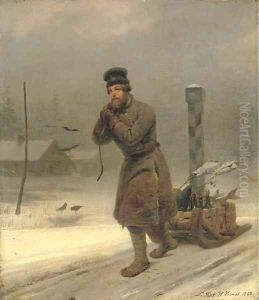Jean Horace Vernet Paintings
Émile Jean-Horace Vernet, commonly known as Horace Vernet, was a prominent French painter of the 19th century, born in the heart of the art world of Paris on June 30, 1789, just before the French Revolution. He was the son of Carle Vernet, a painter himself, and the grandson of Claude Joseph Vernet, a marine artist, establishing a strong family lineage in the art world.
Vernet developed a passion for depicting military subjects and scenes of war, influenced by the turbulent times he lived through, including the Napoleonic Wars. His style was characterized by his attention to detail and dedication to realism, which made his works popular with patrons, particularly the French government and military leaders. He was also known for his historical scenes and portraits.
Despite his focus on military and historical scenes, Vernet also painted a variety of other subjects, including genre scenes, landscapes, and animal paintings. His talent was recognized early on, and he studied at the French Academy in Rome from 1810 to 1811. Throughout his career, he exhibited at the Paris Salon, where he received numerous awards and accolades, solidifying his reputation as a leading painter of his time.
Vernet's popularity extended beyond France as he received international commissions, which allowed him to travel. His work was particularly well received by the French government: King Louis-Philippe commissioned him to produce a series of large-scale paintings commemorating French military campaigns for the historical galleries at the Palace of Versailles.
Horace Vernet's career was not just limited to painting; he was also involved in the administration of the arts. He served as the director of the French Academy in Rome from 1829 to 1835. His tenure there was marked by his encouragement of the students to study nature directly, which was a departure from the more traditional focus on classical antiquities.
Vernet passed away in Paris on January 17, 1863. His legacy is reflected in his numerous works that capture the spirit of the 19th century with vividness and precision, which continue to be exhibited in museums around the world.
